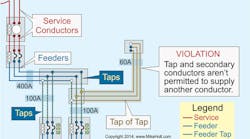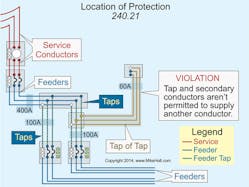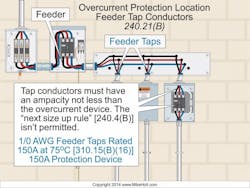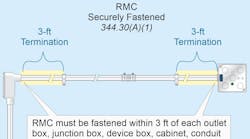All questions and answers are based on the 2014 NEC.
Q. Please explain the 10-ft tap rules?
A. Except as permitted by Sec. 240.21(A) through (H), overcurrent devices must be placed at the point where the branch circuit or feeder conductors receive their power. Taps and transformer secondary conductors aren’t permitted to supply another conductor (tapping a tap isn’t permitted) (see Fig. 1).
Branch circuit taps are permitted in accordance with Sec. 210.19 [240.21(A)].
Conductors can be tapped to a feeder as specified in Sec. 240.21(B)(1) through (B)(5). The “next size up protection rule” of Sec. 240.4(B) isn’t permitted for tap conductors [240.21(B)] (see Fig. 2).
Feeder tap conductors up to 10 ft long are permitted without overcurrent protection at the tap location if the tap conductors comply with the following [240.21(B)(1)]:
The ampacity of the tap conductor must not be less than [240.21(B)(1)(1)]:
a. The calculated load in accordance with Art. 220, and
b. The rating of the overcurrent device supplied by the tap conductors.
Exception: Listed equipment, such as a surge protection device, can have their conductors sized in accordance with the manufacturer’s instructions.
The tap conductors must not extend beyond the equipment they supply [240.21(B)(1)(2)].
The tap conductors are installed in a raceway when they leave the enclosure [240.21(B)(1)(3)].
The tap conductors must have an ampacity not less than 10% of the rating of the overcurrent device that protects the feeder [240.21(B)(1)(4)].
Note: See Sec. 408.36 for the overcurrent protection requirements for panelboards.
Here’s an example problem that helps better explain how to apply these rules.
A 400A breaker protects a set of 500kcmil feeder conductors. There are three taps fed from the 500kcmil feeder that supply disconnects with 200A, 150A, and 30A overcurrent devices. What are the minimum size conductors for each of these taps?
200A disconnect: 3/0 AWG is rated 200A at 75°C, and is greater than 10% of the rating of the overcurrent device (400A).
150A disconnect: 1/0 AWG is rated 150A at 75°C, and is greater than 10% of the rating of the overcurrent device (400A).
30A disconnect: 8 AWG is rated 40A at 60°C. The tap conductors from the 400A feeder to the 30A overcurrent device can’t be less than 40A (10% of the rating of the 400A feeder overcurrent device).
Holt is the owner of Mike Holt Enterprises, Inc. in Leesburg, Fla. He can be reached at www.mikeholt.com.






